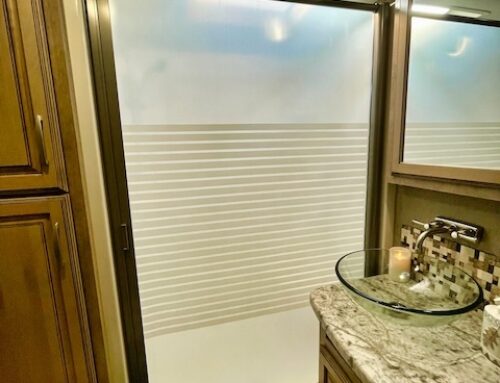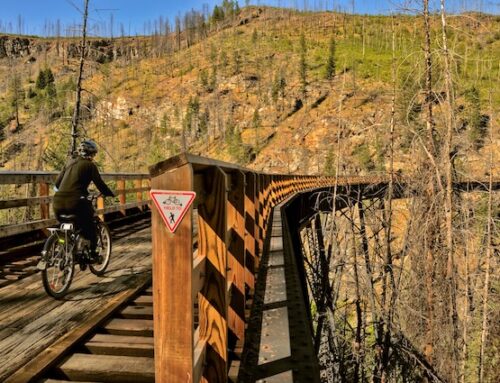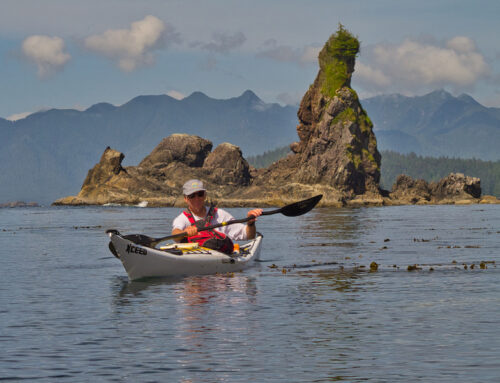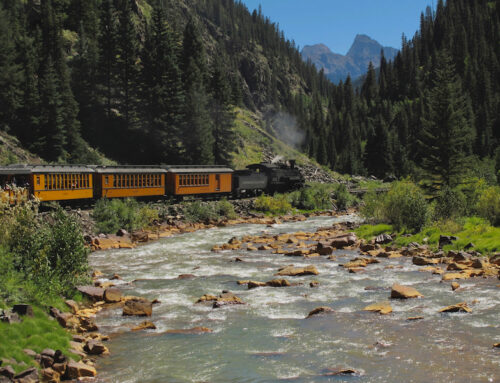A Kayak Trip to Historic Race Rocks
Located on an archipelago of small islands one nautical mile from Rocky Point, the Race Rocks Lighthouse is located on the southern most point on Vancouver Island, British Columbia. It is also the narrowest point in the Juan de Fuca Strait with only 12 nautical miles separating Race Rocks from the American shores of the Olympic Peninsula.
All of the water that fills and drains the Georgia Straits and Puget Sound flow through this constriction creating very strong current flows, reaching speeds of up to 8 knots. This, combined with the fact that this area is also exposed to the swells of the open Pacific, make Race Rocks a particular hazard to navigation and potentially a dangerous area to kayak.
That being said, for the experienced, well prepared paddler, the rewards of paddling here are many. The beautiful, historical lighthouse, the stunning backdrop of the Olympic Peninsula, rocky islets teaming with wildlife and the fun and challenge of negotiating moving water!
The lighthouse at Race Rocks is a beautiful historic landmark and in itself worth the paddle. However, the waters and the many islets surround Race Rocks lighthouse are teeming with sea mammals, sea bird colonies and aquatic sea life making it an extra special place to visit.
The History
It was for these reasons that the British Admiralty decided to build a lighthouse here in 1860, with the light being completed and lit for the first time on Boxing Day of 1860. Race Rocks is the second oldest lighthouse on the BC coast, Fisgard Light, at the entrance to Esquimalt Harbour, being older by one year. The 24.4 m (80′) tower was primarily built of granite blocks. It was originally rumoured that the granite was shipped from Scotland as ballast in ships, but this has been found to be not true. The granite was locally sourced and cut. However, after the granite ran out, the top few meters were constructed of sandstone quarried on Gabriola Island. If you look closely at photos you can see the transition to the smoother sandstone near the top of the tower.
The tower is painted in large black and white bands. This was started by the first lighthouse keeper in order to improve the visibility of the tower against the shoreline during daylight, particularly when viewed from the west. The lighthouse has been automated since 1997 at which time Lester B. Pearson College took over the management of the station and the surrounding Race Rocks Marine Protected Area.
Back before automation in the 1980’s we were very fortunate to get to know the lighthouse keepers of the time, Charles and Joan Redhead who were there from 1982- 1989 and their assistants Warren and Elaine Kennedy. We were always invited in for tea and muffins whenever we paddled out there…lovely people! It also gave us a great opportunity to see the inner workings of a manned lighthouse and an opportunity for some great photo ops!
Kayaking to Race Rocks
The lighthouse at Race Rocks is a beautiful historic landmark and in itself worth the paddle. However, the waters and the many islets surrounding Race Rocks lighthouse have an amazing abundance of marine life with sea mammals, sea bird colonies and an amazing variety of underwater plants and animal life. This is partially due to the isolation of this archipelago, but also to the rich and diverse underwater habitat created by the the fast moving waters rushing through the narrow passage and the cold nutrient rich waters being forced to the surface here.
Certainly, this is one of the most spectacular kayak trips on Southern Vancouver Island.
Things to see, avoid and be aware of on the way to Race Rocks
Race Rocks is an Ecological Reserve: Since Race Rocks is an ecological reserve, extra care must be taken when visiting this sensitive area. Ecological Reserves are areas in British Columbia selected to preserve representative and special natural ecosystems, plant and animal species, features, and phenomena. Ecological Reserves provide the highest level of protection for the maintenance of physical and biological diversity while allowing for research and educational activities.
Race Rocks is an ecological reserve and extra care must be taken when visiting this sensitive area.
Lester B Pearson College: As you leave Pedder Bay Marina, you will pass by the Lester B. Pearson United World College of the Pacific on your left. This is one of fourteen United World Colleges located around the world. It is named after the late Canadian Prime Minister, Lester Bowles Pearson, winner of the 1957 Nobel Peace Prize and early supporter of the College.
The mission statement of the UWC Colleges and of the school is to “make education a force to unite people, nations and cultures for peace and a sustainable future”. The college follows the International Baccalaureate curriculum, which covers the final year of high school and a pre-university year. Up to 100 students a year attend Pearson College hailing from nearly 90 countries.
Ministry of National Defence (MND). On your right, you will pass by Canadian Forces Ammunition Depot (CFAD) Rocky Point. You shouldn’t land anywhere along here and you should definitively not trespass beyond the high tide mark. Do not pick up anything that looks like military ordinance as parts of Rocky Point are used for ordinance testing and as a firing range.
Bentinck Island (MND) : Bentinck Island is the last point you pass before entering Race Passage. Bentinck Island is part of CFAD Rocky Point and is used for explosive’s demolition & training and is well signed as such. Do not land anywhere on this island.
Bentinck Island served as a leper colony, running from 1924 – 1957, and was built to replace another leper colony located on D’arcy Island, in Haro Strait just off Island View Beach. The colony was moved to Bentinck Island because it was closer to the medical quarantine facilities located at William Head Station (1872-1959). The colony was shut down after the last person died there in 1957.
Another notable event concerning Bentinck Island was the Holland America cargo liner Eemdijk, which ran aground on Race Rocks on the 15 of October 1925. She was refloated and beached on Bentinck Island. The tug boat Hope and her crew of seven men were lost attempting to salvage the liner. For a list of other ships wrecked on Race Rocks click this link: Wrecks of Race Rocks.
William Head Institution: As you approach the end of Pedder Bay you will see notice the buildings of an institution on the point to your left. This is William Head, a federal minimum security penitentiary which encompasses the entire point. Do not attempt to land anywhere on this point.
See the map at the bottom of this article for locations of these features.
Guidelines for Paddling around Race Rocks
For complete guidelines please visit the Race Rocks Ecological Reserve website. Common sense should be your guiding principle when paddling around the islets according to the Eco-guardians at Race Rocks. The guardians try to restrict any activity which may cause birds and mammals unnecessary disturbance. Unnecessary movement for the wildlife means extra energy expenditure, and this means more stress for food gathering and territorial activities. The Eco-guardians have observed that people with the best of intentions will often compromise the well being of an animal in order to get closer for a better look or a better photo.
The recommended guidelines for approaching islets with mammal haul-outs and bird colonies is 100 meters (109 yards).
The Race Rocks Eco-guardians remind us that boat access (including kayaks) around the islands can jeopardize the integrity of parts of the reserve. Many paddlers like to think that they because they are in a paddle craft they are very eco-friendly, but observations have shown the stealthy nature of kayaks can be even more disruptive to wildlife because they can take them by surprise.
One area of particular concern at Race Rocks is the cliff beneath the helipad where the cormorants roost and it should be well off limits for any boat approach. Boats should only use the center of the channel in that location. These birds take flight easily and when their eggs are left exposed, it leads to predation by crows and seagulls. Other spots include the seal pupping areas from June to August, and in particular, the channel directly to the South of the tower must be off limits to boats during these months. A reminder that harbour seals are easily spooked at any time of the year when kayaks approach.
Due to the unpredictability of the activities and locations of animal haul-outs or bird nesting, the advice of the Race Rocks Eco-guardian should always be sought before trying to access the islands.
If you are further interested in guidelines for approaching wildlife please check out Friends of Ecological Reserves website.
Wildlife you can expect to see
Among the mammals you are very likely to see are the Northern Sea Lions (formerly Steller Sea Lions), California Sea lions, and Harbour Seals. Rarer but commonly seen in residence are Elephant Seals, the world’s largest pinniped and Race Rocks is home to the northernmost breeding colony of elephant seals in the world! Other mammals seen in the waters around Race Rocks include Sea Otters, Orcas, Grey Whales, Humpback Whales and Dall’s Porpoise.
Some of the birds you can commonly see include: Pigeon Guillemot, Brandts Cormorant, Pelagic Cormorant, Double Crested Cormorant, various species of Gulls, Bald Eagle, Western Grebe, Black Oyster Catcher, Common Merganser, Harlequin Duck, Black Turnstone, Great Blue Heron and many more.
Trip Planning
Warning: The paddle from Pedder Bay Marina out to the mouth of Pedder Bay is a very beautiful and relatively protected paddle for novices. However, crossing the 1 nautical mile (1 nm = 1.15 miles or 1.85 km) passage to Race Rocks should only be attempted by experienced paddlers who have taken the time to do the proper trip planning and have the skills to handle the potentially hazardous currents and wave action that can be experienced here. Make sure you take along the proper safety equipment including some form of emergency communication device. Also, unless you have obtained permission to land on the main island, plan to be in your boat a minimum of 2 1/2 hours, as there are really no other places to land on the way to and from Race Rocks.
Check the Winds & Currents
If you are planning to cross Race Passage, you need to check the forecasted winds and currents (note: if you are uncertain as to the difference between tides and currents, see below*). Strong currents up to 8 knots (9.2 mph or 14.8 kph) can be experienced here. (Keep in mind that anything over 2 knots is considered strong). Unless you are an expert paddler going out to play in rough water we recommend you paddle in currents of less than 2 knots.
Understand the Interaction of Wind & Currents
A very important consideration on a trip to Race Rocks is understanding the interaction of wind and currents, namely that wind blowing against the current will create larger, steeper waves. What can start as a fairly calm crossing in a light breeze can turn into a raging tide rip with the simple change in current direction.
Understand Currents and Times of Slack Water
You need to understand that the time of slack water becomes less and less as predicted currents get stronger. At very strong flows there may be only a few minutes or less of slack water. Also, keep in mind that while the tide and current tables are fairly accurate, they are still only estimates and not exact.
Check the weather forecast
Checking the Wind Speed & Direction
Most importantly, check the winds forecast for the day, both for speed, direction and any predicted changes. Some good weather sites are posted below. Our recommendation for most paddlers is to keep the winds under 10-12 knots or 18 – 24 kph, and remember that wind against the current will create larger, steeper waves.
Here are 3 recommended sites for good wind forecasts:
Enviornment Canada Marine Weather
Check the Currents for Race Passage
1. The easiest way to do this is with a very convenient iPhone app called Aye Tides. Just click ‘Find a Station’ and select Race Passage. If currents are running more than 2 knots caution should be exercised. Strong eddylines (the transition between the main current and slower water near the shoreline) can easily capsize inexperienced and unwary paddlers. Strong currents can also create large standing waves.
2. Using the Canadian Tide and Current Tables. Use the online tables and find the listing for Race Passage (page 68). The times of the turn to Ebb and Turn to Flood (essentially slack water), as well as the time of the maximum current flow are listed. The minus sign refers to the ebb or water flowing out (a westerly direction at Race) and the positive sign is the Flood or inflow (easterly).
*The differences between tides and currents. Tide stations only measure the vertical rise and fall of the water (depth) at high and low water at a particular location. A current station measures the horizontal speed and direction of the water moving past a location. Times of high and low tide do not correspond to changes in current direction, particularly around the southern tip of Vancouver Island. Use the current tables and don’t be tempted to use tide tables to predict slack water.
Other weather considerations
Fog: Fog can form at any time of year at Race Rocks, but is more prevalent through the months of August and September. Sea fog forms here as a result of warmer air meeting the colder waters of the Juan De Fuca Strait. Fog can roll in quickly and completely obscure visibility. You should be prepared with a compass and chart and/or a GPS so you can safely navigate your way back. If you are using a compass, keep in mind you will have to compensate for drift caused by the current. Also, be aware that unlike radiation fog, which forms over land in calm air conditions, sea fog can be associated with high winds.
Water Temperature: The waters here are cold all year round with average winter temperatures running 7.0-8.0˚C (44.5-46.5˚F) and only warming to 10-11.5˚C (50-53˚F) from May through October. In waters this cold exhaustion can occur in 30-60 minutes or less and survival times are between 1-3 hours. It is imperative that you:
1) Have the necessary skills to paddle the rough water conditions that can be found in Race Passage, including self and assisted rescues.
2) Do the necessary trip planning to avoid potentially hazardous conditions and keep in mind that conditions here can change rapidly. Be aware of changing conditions once you are on the water.
3) Wear the appropriate clothing, ie dress for the water temperature. Drysuits are recommended.
4) Have the necessary rescue equipment with you including some form of signalling device and a communication device such as a cell phone in a water proof case (make sure you can operate it while in the case and that your battery is charged), a VHF radio, Personal Locator Beacon (PLB) or satellite communicator such as the Spot or inReach. They could save your life!
I personally like the idea of satellite messengers. They are small, easy to use and not restricted by cell signals or the relatively short range of handheld VHF radios. The inReach can send a signal from anywhere in the world and allows you to be in communication with rescuers via a texting function. To read a full review on the inReach, click this link, or check out our post on all Emergency Communication Devices by clicking the link.
More Pictures
For more images or to purchase images of kayaking to Race Rocks, click this link: Race Rocks
How to get to Race Rocks
Paddling Times
The approximate paddle time from Pedder Bay to Race Rocks is 1 – 1 1/2 hours one way, with a total distance of 4 nautical miles or 7.5 km one way and the same time and distance for the return trip. Plan to be in your boat a minimum of 2 1/2 – 3 hours, as there are really no good places to land on the way to and from Race Rocks.
Places to Launch
Pedder Bay RV Resort & Marina
Pedder Bay RV Resort & Marina – 925 Pedder Bay Drive. Check in with the Marina office. Launch fees are $10.00 per boat (any size) for use of their facilities.
Driving Directions to Pedder Bay:
Approximate driving time from downtown Victoria to Pedder Bay Marina: 45 min with a total distance of 31 kms.
Drive north out of town on Douglas St/Trans-Canada Hwy/BC-1 N
Continue on Trans-Canada Hwy/BC-1 N.
Exit to BC-14 W/Sooke Rd, Left on Happy Valley Rd, Right on Rocky Point Rd, left on Pedder Bay Rd in Metchosin.
Pearson College
It is possible to launch from Pearson College – 650 Pearson College Dr. You may want to check in with them for permission and access to parking. Phone: 250-391-2411 or info@pearsoncollege.ca
Driving Directions to Pedder Bay:
Take Craigflower Rd, Island Hwy, Sooke Rd and Metchosin Rd to William Head Rd in Metchosin. Continue on William Head Rd. Drive to Pearson College Dr. Approximatley 45 minutes from downtown Victoria.
Weir’s Beach
You can leave from Weir’s Beach off Sandgate Rd in Metchosin and paddle out and around William Head. There is a gravel parking area along the road. There is not a lot of parking, so space can be at a premium in summer months. Since Weir’s Beach is exposed to Juan de Fuca Strait, you can sometimes get waves rolling in on the beach making launching more challenging. Also, if you leave from Weir’s Beach your entire paddle to Race Rocks will be a more exposed to the weather.
Driving Directions to Weir’s Beach:
Drive north out of town on Douglas St/Trans-Canada Hwy/BC-1 N
Continue on Trans-Canada Hwy/BC-1 N.
Exit to BC-14 W/Sooke Rd, Left on Metchosin Rd,
Left on Sandgate Rd, to Weirs Beach Public Access, in Metchosin.
The approximate paddling distance from Weir’s Beach to Race Rocks is 4.0 nautical miles or 7.5 kms.






























I have been browsing on-line more than three hours lately, but I never found any attention-grabbing article like yours.
It’s beautiful value enough for me. Personally, if all web owners and bloggers made just right content as you probably did, the web will be a lot more helpful
than ever before.